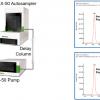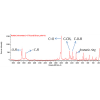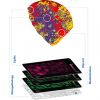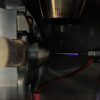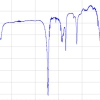Robert Bradshaw and Simona Francese
Biomedical Research Centre, Sheffield Hallam University, Sheffield, UK. E-mail: [email protected]
Introduction
Matrix-assisted laser desorption ionisation mass spectrometry (MALDI MS), both in profiling and imaging mode, is a clearly emerging analytical technique for the analysis of latent fingermarks. Its development, pioneered at Sheffield Hallam University (SHU), in the UK, dates back to 2008, although the first published article appeared in 2009.1 Since then, this technology has rapidly proven its capability for the detection of fingermark chemistry as well as exploiting the chemical content to generate 2D images of level 1 and level 2 details mainly and to separate overlapping fingermarks.2 The chemistry of fingermarks is of particular interest because the detection of both endogenous and exogenous species helps to narrow down the pool of suspects by profiling the offender, their lifestyle and potentially contributing to depicting the forensic scenario. Although MALDI MS has proven to be versatile in terms of the exploitable mass range, even in the context of fingermarks, the majority of the work at SHU has focused on small molecules such as lipids (one of the endogenous classes of molecules) and contaminants such as low molecular weight polymers (as found in lubricants), medications, toiletry products and drugs of abuse. Despite its versatility, isobaric species may be a problem (as with all mass spectrometric techniques) and if not carefully addressed and investigated, this issue jeopardises the reliability of the information and the credibility of the technology; more importantly, it could adversely impact on the acquittal or conviction of the suspect. Prior to claiming detection of a mass-to-charge (m/z) species, further analyses are needed to confirm its identity. Surprisingly, despite the risk and the severe forensic implications of not pursuing this route, occasionally, peer reviewed papers have been published claiming the detection of species such as drugs and explosives on the basis of the observed m/z (and no reported relative error)with no further confirmation analyses.3,4 Potential solutions include: the use of high mass resolving power (HRMS) instruments or ion mobility separation (IMS) (to which we at SHU now routinely resort). Both methods are extremely efficient but not widely available in laboratories because of the financial implications. In this short article we offer some examples of how we use MALDI MS/MS imaging as an alternative to HRMS and IMS to address the problem of isobaric species in latent fingermarks analysis, reporting on three species: an endogenous fatty acid (oleic acid), a drug of abuse (cocaine) and the antibacterial chemical dimethylbenzylammonium ion (DMA) found in many toiletry products. MALDI MS imaging analyses and tandem MS were conducted on a modified Applied Biosystems (Foster City, CA, USA) API Q-Star Pulsar i hybrid quadrupole time-of flight (qTOF) instrument.
Results and discussion
One way of enabling confirmation of small molecule detection in fingermarks using MALDI MS/MS was published by us in 2013; this confirmed the presence of the endogenous oleic acid (OA, m/z 283.26).5 Here we undertook MALDI MS/MS imaging analysis of this endogenous fatty acid by depositing a groomed latent fingermark1 onto an aluminium slide and later prepared the sample using the dry–wet method.5 The OA standard was spotted at two different concentrations next to the latent fingermark. MALDI MS/MS imaging analysis of the parent ion at m/z 283.3 was performed on the whole area, including both the mark and the standard spots. Interrogation of the imaging software during image processing revealed that the precursor ion at m/z 283.3 and its ion products (examples reported for ions at m/z 265.3, 209.2 and 171.1) lit up both in the standard spots and in the mark. Therefore, even though the presence of additional isobaric species could not be excluded, this experiment confirmed the presence of the OA target molecule (see Figure 1).
![Figure 1. Confirmation of the identity of the endogenous oleic acid (OA). MS/MS experiments were preliminarily carried out on an OA standard (Ai) as well as on the corresponding endogenous form in a fingermark (Aii). For OA, a MALDI MS/MS imaging experiment was carried out to confirm the identity of this fatty acid in situ (B i–iv). [Adapted with permission from Wiley from Reference 5, Ferguson et al., J. Mass Spectrom. (2013)].](/sites/default/files/articles/MS-Fig1-26-4.jpg)
Tandem MS can also be applied at a later time in profiling mode (Figure 2).

For example, a recent MALDI MS imaging analysis has revealed the suspected presence of cocaine in a real crime scene mark (Figure 2A) preliminarily developed by the crime scene investigators on a recovered laptop following development using aluminium powder. As the lifted mark lacked sufficient ridge detail for offender identification, it was given to the authors at SHU who applied a-CHCA (a-cyano-4-hydroxycinnamic acid) matrix as previously described.6 After MALDI MS imaging, MALDI MS/MS profiling was performed on the cocaine parent ion at m/z 304.15 and the majority of resulting product ions were assigned to the structure of cocaine ion fragments (Figure 2B) thus confirming the presence of this drug. The presence of both cocaine metabolites was also putatively detected by MALDI MSI showing similar molecular distributions as that of the parent ion. However, MALDI MS/MS analysis could not be successfully performed, therefore, there is only an indication that the offender might have consumed cocaine rather than just handling it.
As previously anticipated, the presence of isobaric species can be particularly problematic when giving evidence in Court; cocaine, (monoisotopic m/z 304.1548) and the common antibacterial DMA (monoisotopic m/z 304.3004) have the same nominal mass but depict a completely different forensic scenario. Instrumental mass resolving power, ionisation competition and co–presence of even more species with the same nominal mass could greatly impinge on data interpretation and, as for the OA example, the use of reference standards can be very helpful. In another example, we have prepared two natural fingermarks7 by (a) rubbing a fingertip against a glass slide containing the dry residue of cocaine (5 µg in total) and (b) wiping a fingertip using Dettol® anti-bacterial surface wipes containing DMA, before depositing separate marks onto aluminium sheets. Both the cocaine and DMA standards were spotted in two separate locations at the side of each contaminated mark, which had been prepared using the dry–wet method.5 For each mark, MALDI MS/MS imaging analyses of the parent ions at m/z 304 was performed on the whole area, including both the mark and the spotted standards. As Figure 3A shows, when data processing, if the software is interrogated for the presence of the ion at m/z 304.2, the mark contaminated with cocaine lights up. However, both of the cocaine and DMA spots become visible; this circumstance shows that a simple MALDI MS image, even with spotted standards, cannot provide certainty in molecular identification. However, if the software is interrogated for the presence of specifically cocaine ion fragments (m/z 182.1, 150.1, 82.1), only the cocaine standard spot lights up together with the mark (Figure 3A).

The same applies to the DMA contaminated mark where only the DMA specific product ions (m/z 212.2, 91.0, 58.0) generate an image of both the mark and the standard DMA spot whereas the standard cocaine spot is not visible (Figure 3B). The overlay of the images from a specific DMA product ion (m/z 212.2) and a cocaine product ion (m/z 182.2) highlights that cocaine is absent in the mark and only present in the standard. As shown here, the application of tandem mass spectrometry, which the mass spectrometric community widely adopts for molecular confirmation, may work even without HRMS and IMS using reference standards.
Conclusions
If high mass resolving power or ion mobility instruments are not available, tandem mass spectrometry is indispensable to confirm a molecule’s identity, especially when results are to be used as evidence in Court. When employing MALDI MS/MS imaging in a targeted approach, the presence of multiple ion products of the species under investigation is essential and the use of standards to spot to the side of the mark may greatly assist in confirming the identity of the molecule of interest.
References
- R. Wolstenholme, R. Bradshaw, M.R. Clench and S. Francese, “Study of latent fingermarks by matrix-assisted laser desorption/ionisation mass spectrometry imaging of endogenous lipids”, Rapid Commun. Mass Spectrom. 23, 3031 (2009). doi: http://dx.doi.org/10.1002/rcm.4218
- S. Francese, R. Bradshaw, L.S. Ferguson, R. Wolstenholme, S. Bleay and M.R. Clench, “Beyond the ridge pattern: multi-informative analysis of latent fingermarks by MALDI mass spectrometry”, Analyst 138, 4215 (2013). doi: http://dx.doi.org/10.1039/c3an36896c
- K. Kaplan-Sandquist, K. LeBeau and M.L.A. Miller, “Chemical analysis of pharmaceuticals and explosives in fingermarks using matrix-assisted laser desorption ionization/time-of-flight mass spectrometry”, Forensic Sci. Int. 235, 68 (2013). doi: http://dx.doi.org/10.1016/j.forsciint.2013.11.016
- F. Rowell, K. Hudson and J. Seviour, “Detection of drugs and their metabolites in dusted latent fingermarks by mass spectrometry”, Analyst 134, 701 (2009). doi: http://dx.doi.org/10.1039/b813957c
- L.S. Ferguson, S. Creasey, R. Wolstenholme, M.R. Clench and S. Francese, “Efficiency of the dry–wet method for the MALDI-MSI analysis of latent fingermarks”, J. Mass Spectrom. 48, 677 (2013). doi: http://dx.doi.org/10.1002/jms.3216
- R. Bradshaw, S. Bleay, R. Wolstenholme, M.R. Clench and S. Francese, “Towards the integration of matrix assisted laser desorption ionisation mass spectrometry imaging into the current fingermark examination workflow”, Forensic Sci .Int. 232, 111 (2013). doi: http://dx.doi.org/10.1016/j.forsciint.2013.07.013
- R. Bradshaw, W. Rao, R. Wolstenholme, M.R. Clench, S. Bleay and S. Francese, “Separation of overlapping fingermarks by matrix assisted laser desorption ionisation mass spectrometry imaging”, Forensic Sci. Int. 222, 318 (2012). doi: http://dx.doi.org/10.1016/j.forsciint.2012.07.009




